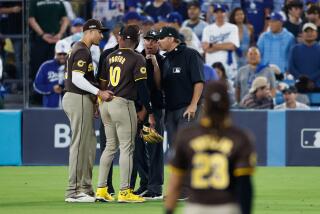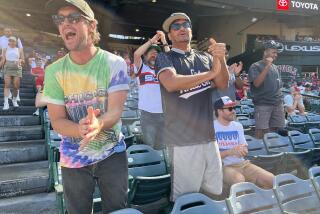KCAL Missed a Chance to Deliver Real News
It was an August night in Anaheim, traditionally a time and place where the only things you see falling are the Angels in the standings.
So what was this? Foul balls hurled by angry fans back onto the field? Half-filled water bottles flung dangerously from the upper deck? Outfielders getting hit in the back by pizza boxes? Television crews running for cover, running for their safety?
At Edison Field?
Home of the Big A in the parking lot and the big Zzzzs in the stands?
It had to be seen to be believed.
Which, depending the television feed you happened to be viewing Thursday night, was easier said than done.
Fox, which carried the Angel-Devil Ray game live for Tampa, Fla., covered the disturbance for what it was: a developing news story. There were images of fans, frustrated by the increasing possibility of a players’ strike the following morning, picking up baseballs fouled into the stands and firing them back onto the field. There were shots of fans chanting, “NO STRIKE!,” shots of garbage strewn across the warning track, shots of dollar bills wadded up in disgust and tossed onto the dugout roof.
This was the same footage eventually shown to the rest of the nation on ESPN’s “SportsCenter,” and across the Southland on local news broadcasts.
KCAL Channel 9, which televised the game locally, showed precious little of that. Its announcers--Steve Physioc, Rex Hudler and John Ireland--made mention of the fans’ behavior, but visual evidence was highly conspicuous by its absence. Channel 9 kept its cameras dutifully trained elsewhere, even as the game was delayed to clean up the debris.
Channel-surfing viewers had to wonder what was--or wasn’t--going on. Judging from its highlight package, ESPN appeared to be covering an English soccer riot (Tampa Bay at Leeds?) or a bad call that went against the Browns in Cleveland. Meanwhile, the same game on Channel 9 seemed to be just another 6-1 Angel victory, except with lots of close-ups of players and coaches looking more distracted than usual.
That was by intent. According to Jeff Proctor, KCAL executive sports producer, “Our feeling is that generally if you show people doing kind of idiotic things, it encourages them to do it....
“Had we been at Fenway Park or in New York, it might have made air. Because our initial inclination is to make sure the Angels are put in a good light. By showing the fans throwing stuff, a) we don’t want to encourage that behavior, and b) we don’t want to put the Angels in a bad light, as their telecaster, as their broadcaster.”
On one level, of course, this makes perfect sense. Usually, the Angels need no help at all casting themselves in a bad light. Usually, they need all the backup they can get.
But such thinking casts a bad light on another level, the one they teach in Journalism 101. News is news, regardless of where it happens. Channel 9 had a choice Thursday night: Do we serve the viewers, who have the right to know what’s happening, or do we serve the Angels?
Given those alternatives, Channel 9 opted for happy public relations over good journalism.
This was not just another night at Edison Field. Outside the ballpark, KTLA Channel 5 sportscaster Tony Hernandez and his crew were forced to move the site of their postgame remote broadcast when angry fans leaving the stadium began crowding around them.
“It was hairy,” said Tom Klimasz, KTLA senior sports producer. “Once we set up and put on the lights, it was just like a magnet for the crowd. And it really, really got ugly.”
Klimasz estimated he and the Channel 5 crew were surrounded by a crowd of 150--”mostly teenagers and young kids, like in their early 20s ... and they were pretty tanked.”
After being advised by police to either move their equipment or cancel the remote for their own safety, Klimasz placed a phone call to his studio.
“Our segment was supposed to come up at about 10:09,” he said. “At 10 o’clock, I called the executive producer and said, ‘No way. Safety is a big issue right now.’ ”
The crew packed up its van and drove around the stadium, eventually setting up next to the Amtrak station, where they were able to film their 10:45 p.m. sportscast in peace.
“I haven’t been that scared in a while,” Klimasz said. “I was inside Staples, fortunately, the night of the Laker-Pacer championship [clincher]. But my cameraman, Brian Dunn, was there. And he said [Thursday night] was similar.”
Channel 9 viewers had to wait for the postgame show and the following newscast for a true sense of what happened. Immediately after the game, Ireland, from the third-base dugout, informed his audience why there would be no player interviews--because “the situation had gotten pretty ugly” and stadium security staffers had instructed players to leave the field.
Ireland then led off the newscast with a report on the disturbance, finally airing the scenes that Channel 9 elected not to show during the game. The footage had to be lifted from the Fox feed, complete with Fox logo at the top of the scene, because the production staff in the Channel 9 truck did not include those images in the highlight package it sent to the studio.
Better late than never? That is one rule-of-thumb concept that works better at a New York labor negotiation table than a TV production truck parked outside Edison Field.
More to Read
Go beyond the scoreboard
Get the latest on L.A.'s teams in the daily Sports Report newsletter.
You may occasionally receive promotional content from the Los Angeles Times.






